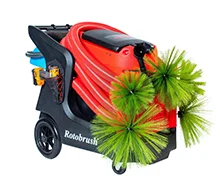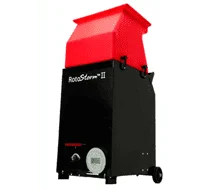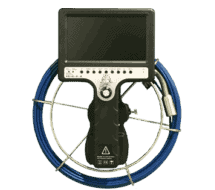
- Rotobrush International
- As Seen In, News
A number of trends are continuing to affect all segments of the IAQ market. These include product evolution, health concerns, system knowledge, and of course, the economy.
“The Air Duct Cleaning (ADC) industry is highly susceptible to economic changes, as many homeowners consider residential duct cleaning a luxury rather than a necessity,” said Lane Jeffryes, CEO of Rotobrush International. “Unfortunately, this type of service often receives a lower priority status in harder economic times, despite the EPA ranking indoor air pollution as one of the top-five health risks in the nation.
“Success in the ADC industry depends on the ability to recognize potential purchase drivers for clients,” he said, “and then investing in marketing programs that align with potential client mindsets.”
According to Jeffreys, independent firm ABA Consulting conducted surveys with several hundred homeowners across the United States, and uncovered the top-five reasons for having their air ducts cleaned:
- A situation called for it (i.e., there was a smell, dirt, or a neighbor getting ADC).
- They consider themselves a “clean freak.”
- They felt that dirty equals unhealthy (i.e., “Dirt aggravates my allergies or asthma.”).
- They are price driven (they want assurance that they are getting the best value for their investment).
- They felt it was time to get it done.
“Our customers tell us that they want to offer more value to their customers and be more competitive in the market,” he said. “We do this by training contractors to maximize HVAC products by diagnosing houses and offering both indoor air quality and energy efficiency solutions to homeowners.”
Rotobrush offers business owners tips and techniques during their training sessions. “Contractors spend day one on whole-house contracting techniques,” Jeffryes said. “On day two, contractors learn from industry experts like Vicki and John LaPlant, how to close in-home sales, marketing techniques, and business finance.” The company also offers RotoVantageSM, a member network for best practices sharing, education, and leadership.
“Right now, homeowners have IAQ on their minds,” said Jeffryes. “So if you’re on a tune-up, a service call, or doing a changeout, why not pick up the additional revenue? Clean and seal the ducts, offer an enhanced filtration system, check their insulation levels, and help them get the most out of their HVAC systems.
“Your customers will love the added value, and they’ll be more likely to recommend you to their friends and family.”
HEALTHY LIVING
Homeowner awareness of the correlation between IAQ and health continues to be a top trend, our industry contacts agreed.
“There are many health advantages to clean indoor air,” said Joyce Warrington, American Standard Heating & Air Conditioning, HVAC brand marketing manager. “Over 72 trillion allergens find their way into your home daily,” including dust, pollen, pet hair/dander, dust mites, mildew, lint, fungus, most tobacco smoke, cooking grease, and bacteria.
“Many of these particles are so small that your nose and throat can’t filter them out, and they can get deep into your lungs,” she said. Filtration products like the manufacturer’s AccuClean™ are said to remove up to 99.98 percent of these allergens from filtered air, addressing this customer concern.
“Studies show that indoor air can be up to five times more polluted than outdoor air,” Warrington said. “Families spend most of their lives at home and indoors, so they want to make sure their family is breathing the cleanest air possible.”
In addition, today’s tighter homes also can seal in indoor pollutants, especially as more people seal up their homes to lower their utility bills. Finally, the increased use of synthetic building materials and furnishings and household cleaners adds to the concentration of indoor pollutants.
PRODUCTS EVOLVE
Get to know your customers! Do they think they have an IAQ “situation?” Do they think they are clean freaks, or feel that dirt aggravates a medical condition? They may be potential duct cleaning customers.
“There have been a whole list of products, like whole-house air cleaners, that are getting better, but it’s evolutionary rather than revolutionary,” said Dennis Wierzbicki, COO of Mid-Way Supply Inc. Whole-house air cleaners, for example, have improved in their energy efficiency and ease of use, becoming less restrictive of airflow, with improved user interfaces, he said.
Let’s not forget the dilution portion of the IAQ solution. Henry “Skip” Ernst, a technical expert at McQuay, helped in the development of the Maverick II commercial rooftop system, which is optimized for 100 percent outdoor air. Outdoor air control, he said, is “a fairly common option now to measure the amount of air coming in and adjusting the damper accordingly.
“Also, drain pans are draining better,” he added, which helps address moisture-related issues to a degree. “And units are much easier to keep clean,” he said, with better access doors and double-wall construction. “Better quality is provided and required.”
Increased outdoor air doesn’t need to mean more costly operation. “Indirectly, there are more requirements for energy recovery,” he continued. “Wheels are the most common solution, providing the most Btu per dollar, and they do a good job of recovering latent energy.”
However, he pointed out that in some cases, “the exhaust air is dirtier than you would normally see. Wheels do not provide good separation between outdoor air and intake. Plate-frame heat exchangers are more commonly used, and they require less maintenance.”
Finally, he pointed out that people are now readily using MERV-8 minimum-efficiency filters as recommended in ASHRAE Standard 62.1.
Contractors can and should utilize these product trends, Ernst said, to help keep their customers satisfied. “IAQ problems are huge for owners. These system options are almost becoming requirements now. You have to bring in the right amount of outside air and make sure the system can be cleaned. More and more owners are demanding these options.
“Some owners are good technical people,” he said, “or they hire consultants. ASHRAE set the bar” with its ventilation-IAQ standard, “and the industry responded in a free-enterprise way.”
THE WHOLE SYSTEM
There also seems to be growing awareness of the role the entire system plays in a building’s air quality. “IAQ a decade ago meant predominantly air filtration and possibly disinfecting for biological contaminants in the airstream,” said Ross Soyka, director of marketing, Mainstream Engineering.
“Today, however, we see more service techs realizing that there are other important factors such as humidity, ventilation, and building envelope construction to consider.
“Another factor is equipment sizing,” he said, “which … plays an important part in humidity. The days of putting in an extra-large air conditioner should be numbered for energy reasons, but just as importantly for humidity issues.
“A central air conditioning unit sized too large will satisfy the thermostatic set point without running an adequate enough time to also reduce the humidity down to an optimum 45 to 50 percent,” Soyka said. “In a relative humidity environment of 70 percent or more, mold can develop on interior building services and contents in just 48 hours.”
Another trend, he said, is that “vocational schools are showing an interest in supplementing their conventional refrigeration instruction with IAQ training. Few schools up to this point really train or certify their students in IAQ.” Mainstream now offers a Universal Certification course to vocational schools.
CONTRACTOR AWARENESS
Among contractors, “I think we are seeing more contractor openness,” said Wierzbicki, because the economy is forcing them to ask themselves, “‘What else could I be selling in this difficult economy — IAQ, consulting services, efficiency?’ These offer opportunities for a lot of our contractors.”
This supplier’s training facility, Mid-Way University, provides technical and business-related training. “We’ve held some seminars here about emerging technologies,” Wierzbicki said. “Some of these things we know are coming forward; others are leading us.”
Some contractors are already there. Steve Lauten, president of Trane dealer Total Air & Heat Co., Dallas, said, “As a contractor, we like to begin our recommendations by collecting data. We use an IAQ monitor that provides us with the data necessary to help the customer make informed decisions. We typically find elevated levels of particulates and VOCs.
“Using this information, we show our customers which options are available,” Lauten said. “Our customers have been extremely pleased with the results offered by CleanEffects. It has proven to be the most effective filter we offer, yet it remains simple to maintain.”
One thing contractors should never do with these customers, he said, is to “make promises that can’t be backed up. You need to understand what’s going on in a structure, and the needs of the occupants, before recommending a solution. Offer solutions that are comprehensive enough to address the issues related to the structure.
“I recommend taking some classes on IAQ, Sick Building Syndrome, and green building principles,” he said. “Understanding how the structure was built is critical in order to make the correct recommendations. Consumers are depending on you, the contractor, to help them make good decisions. Understanding what’s available is critical, so take advantage of the online training classes offered by your HVAC manufacturer.”
"*" indicates required fields



























